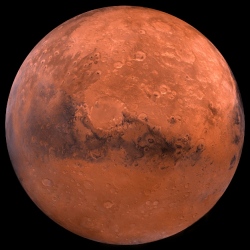
NASA’s Jet Propulsion Laboratory (JPL) has invited representatives from space organisations around the world, including the Indian Space Research Organisation (ISRO), to a meeting in Washington next month, where they’ll discuss how they can work together on the journey to Mars, according to reports.
ISRO has already proved that it has the ability to get to the Red Planetary efficiently, the space agency spent only US$74 million (less than the budget of the film Gravity) on their Mars Orbiter Mission, which put spacecraft Mangalyaan into the Red Planet’s orbit on its first attempt. And now it appears NASA might want to capitalise on some of that knowledge in order to help humans get to the red planet sooner.
"Reaching the Mars orbit in first attempt was an amazing achievement and that too at such low cost," Charles Elachi, director of JPL, told the Press Trust of India (India’s answer to the Associated Press). "Now American scientists through its MAVEN mission and India through its Mars Orbiter Mission are sharing data."
Official details of the collaborative discussions are thin on the ground, but according to the Press Trust of India, NASA isn’t only reaching out to ISRO for future collaboration, but also a range of other European countries, with the overall goal of getting humans to Mars faster.
"Shortly, there is a meeting in Washington on possible collaborations for the next five to six mission to Mars and ISRO is invited for that meeting," said Elachi. "This is in preparation for the ultimate human space flight to Mars … Hopefully, India will be part of the consortium between the US, Europe, France, Italy, among others, where all can capitalise on our capabilities to explore the Solar System."
Just how much India would bring to the mission isn’t clear as yet, but the Indian media are pretty excited about the possibility of the country potentially contributing astronauts to a mission (its own human space flight program is currently planning its first manned missions).
To be clear, despite the Press Trust of India claiming: "In future, India and the US could jointly explore Mars and who knows an Indian astronaut could also head to the Red planet on a joint mission," there’s no indication that foreign astronauts will be involved in a NASA mission any time soon.
It’s also not the first time ISRO and NASA have worked together. The two space agencies signed on to co-launch an Earth-orbit satellite on 30 September 2014, just a few days after Mangalyaan entered Mars’s orbit. But the long-term goal was always to have ISRO collaborate with NASA deeper in the Solar System.
"The signing of these two documents reflects the strong commitment NASA and ISRO have to advancing science and improving life on Earth," NASA Administrator Charles Bolden said at the time. "This partnership will yield tangible benefits to both our countries and the world."
The satellite, known as NISAR (or the NASA-ISRO Synthetic Aperture Radar), is set to be launched in 2020, and will involve equal input from both countries in order to better monitor and understand climate change and natural disasters.
But despite equal billing with NISAR, in the case of the Red Planet, NASA and NASA astronauts will still most likely be heading up the mission to Mars. For now, anyway. The reality is that it’s going to take as many minds as possible to get our species off this planet and onto one that’s on average 225 million kilometres (140 million miles) away, and we think it shouldn’t matter where those minds come from.
